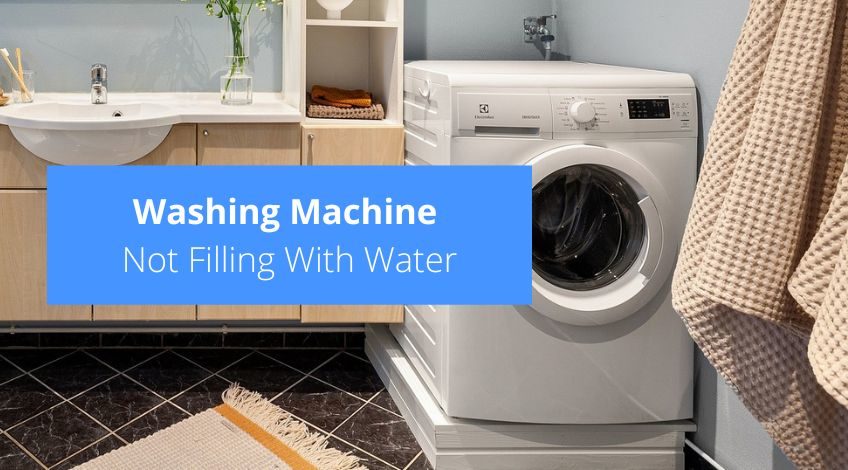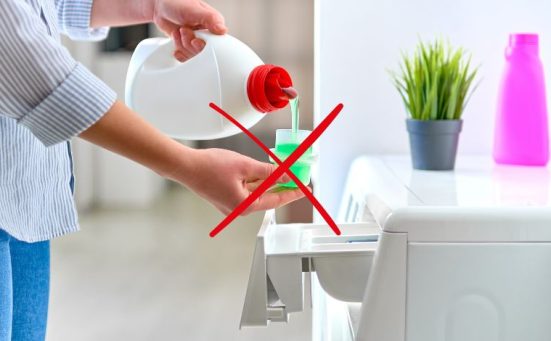
Washing Machine Not Filling With Water? (water not going into washer explained)
There’s not much point of a washing machine that doesn’t fill up with water. The laundry can’t be washed without the addition of water and yet, this is a very common fault. So if your machine isn’t filling with water, you need to keep reading.
Why Is My Washing Machine Not Filling With Water?
There are several reasons why your machine isn’t filling with water so let’s start with the basics and take it from there.
Below are the main reasons why your washing machine might not be filling with water. Starting with the most common.
Washing Machine Door Is Open
This might seem obvious, but you’d be surprised at just how many times the cause is as simple as the door isn’t shut properly or at least the machine thinks the door isn’t shut properly. On many machines unless the door lock control doesn’t signal to the control board that it’s locked, the inlet valve will not open.
If you’re sure the door is closed but you suspect the interlock device is at fault, it can be tested using a multimeter for electrical continuity. This will tell you whether it needs to be replaced or not. If you don’t know how to use a multimeter, we recommend you contact an engineer to diagnose and repair your machine.
There are a few warning signs which could indicate the interlock is at fault which are, the door doesn’t seem to close as smoothly as it used to, or, there are a number of clicking sounds after the program is turned on but the door refuses to latch.
If you’re sure it’s not anything to do with the door, you need to check the following;
Water Supply Turned Off
The first thing to do is to check that the supply tap to your machine is turned on and that the inlet hose is free from kinks or bends which could inhibit the water from entering the machine.
Inlet Hose Blocked
If the inlet hose is blocked, the water can’t get into the machine. To check this you’ll need to unscrew the inlet hose and put the end into a bucket. Then turn the valve to the open position and see if there is a fast flow of water leaving the hose.
If the water flow is slow, it could be because the valve isn’t working correctly, this is quite common as the plastic tap can easily become cracked over time.
Then you turn the plastic tap but the metal connector underneath fails to move. If this is the case the connecting piece of metal can usually be turned using pliers, but ultimately the valve will need replacing.
Inlet Filter Blocked
Once you have removed the inlet hose from the machine, you can check the inlet filter which is located on the water valve which the inlet hose screws onto in the washing machine. It is possible to pull the filter down using pliers and clean it before replacing it onto the water valve and retightening the inlet hose.
Take care not to damage the filter as they are pretty delicate and can be quite brittle. If you were to damage it just slightly, it could allow grit or dirt into the inlet valve which could cause it to not shut off properly and cause flooding.
Faulty Inlet Valve

The inlet valve controls the flow of water through your washing machine and is connected to the inlet hose. If the valve has developed a fault, the machine might not fill with water at all. If this is the issue, you’ll probably need an engineer to fix this for you.
Clogged Pump Filter
The pump filter is located at the front, bottom of the machine, usually behind a flap which can easily be opened. Once you locate the pump look for a screw cap and unscrew it. Take care as some water will fall from the screw as it is undone and you might want to put a towel on the floor first to collect this water in.
Unscrew the cap and remove the attached filter from the machine, give the filter a good wash and replace it into the machine. Most washing machine manufacturers recommend cleaning the pump filter on a regular basis.
Drain Pipe Blocked
If the drain pipe is blocked the machine will still have water in the system. This will be detected by the control board which will prevent the machine from allowing more water in which would cause the machine to leak and potentially cause a flood.
Check that the drain hose isn’t kinked, blocked or pushed too far into the standpipe on the wall. It should be no more than 6 inches (15 cm) into the standpipe.
Faulty Water Level Switch
The water level switch controls the amount of water that enters your machine, to prevent overfilling and potential flooding incidents. If the water level switch develops a fault, it could prevent water from entering the washing machine. This is another one best left to an engineer.
Blocked Pressure Chamber
The pressure chamber works by detecting the change in air pressure as water replaces air in the pipe leading to the switch. Sometimes this pipe can get an air lock which leads the switch to detect water when there is none.
If you feel capable, you can often cure this yourself by removing the pipe from the switch and blowing into it then replacing the pipe. This can sometimes be enough to free up the switch and get it running correctly again.
The best way to check if this is the problem is to start the machine and watch what happens. If the machine starts up and the drum turns but no water enters the machine, there’s a good chance that this is the problem. As soon as you detect this, turn the machine off immediately otherwise the heating element will try to heat the non-existent water which could cause serious damage to the machine and in extreme cases, could cause a fire.
Faulty Selector Switch
The selector switch allows you to choose the wash, rinse and spin cycles on your washing machine. When you select a particular program, the selector switch sends a message to the water inlet valve to open the water valve and allow water into the machine. If there is a fault with this switch it can’t send the message and the machine won’t fill with water.
You can check this yourself with a multimeter, but unless you know what you’re doing, it’s best left to an expert. We therefore advise you to call an engineer.
Frequently Asked Questions
There could be a number of reasons why there is no water going into your washing machine including; the washing machine door isn’t closed, the water supply is off, the inlet hose is bent or kinked, the inlet valve is faulty, the pressure switch is faulty, the filter is clogged or the water level switch is faulty.
The pump filter on a washing machine is usually located at the bottom front of the machine, behind a removable flap.
There are a few reasons why your washing machine isn’t filling with water, they include; the water supply is turned off, the inlet hose is bent or kinked, the inlet valve is faulty, the machine’s door isn’t closed correctly, a faulty pressure switch, the water level switch is faulty or the pump filter is clogged.
Also, follow us on Pinterest ...



